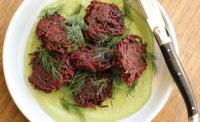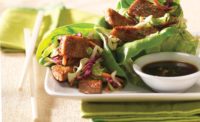Vegetables as Meat Replacers— Not Analogs— Find Their Way Back to Center Plate
The Cutting Edge of Veg: Interview with Susan Guerin, CEO of World Finer Foods, Inc. and Cutting Vedge, Inc.
The plant-based meat analog explosion started out as a disruptor in the prepared foods field and is currently going through some serious growing pains. But the idea of crafting meat, poultry, seafood, and dairy replacers derived from plants and other non-animal sources goes back centuries. Think: tofu. While there’s no argument that the main driver of the consumer love affair with meat-free options has been the technological boom that allowed for meat, poultry, and seafood mimics that have become increasingly close in flavor, texture, and other organoleptic aspects of their animal-based counterparts, the catalyst was also the demarcation between meat analogs and meat replacers.
Half a century ago, the focus was on such items as bean burgers, lentil burgers, vegetable patties, and the like that could sit in for meat without simulating it. But the idea of a product that directly re-created in plant form its animal version was almost anathema to the primary demographic of consumers seeking these products—vegetarians. Once the flexitarian trend took off, however, with consumers recognizing they didn’t have to wholly commit to an animal-free lifestyle and could go meatless just some of the time, the rush to satisfy this majority that actually likes the taste and texture of beef, chicken, and fish became a flood.
That flood of meat and poultry analogs ended up sweeping aside an important aspect of plant-based foods, however. There’s enormous untapped opportunity and value in the plant-based foods that actually show off the plants they are based on rather than reducing them to their protein components. One company that has recognized that opportunity is World Finer Foods, Inc. and its subsidiary, Cutting Vedge, Inc., makers of burgers, meatballs, crumbles, and sausage replacers from artichokes. The company proves that there’s still plenty of room for growth and development in the world of plant-based foods, especially when it comes to having the individual produce representatives take a central role.
Artichokes are a superfood, with multiple benefits that incorporate flavor, texture, and an impressive package of nutrients ranging from vitamins (especially vitamin C), minerals (particularly iron and magnesium), and fiber. (Artichokes are a major source of inulin, a prized prebiotic short-chain fiber known as a fructo-oligosaccharide.) “We think of Cutting Vedge as ‘veggie forward.’ bringing vegetables to the center of the plate, celebrating veggies, and introducing them in consumers’ favorite formats, like burgers, meatballs, and sausage—but while all the time not imitating meat,” expounds Susan Guerin, CEO of World Finer and Cutting Vedge.
What makes Cutting Vedge especially unique in plant-based meat substitutes, according to Guerin, is that the primary ingredient is artichokes. “We use the heart of the artichoke for a tender and meaty bite, and we also include other non -GMO ingredients such as chickpeas, spinach, quinoa, herbs, and some pea protein for a protein boost,” she adds.
Cutting Vedge also is looking into future creations from other vegetables. As the meat analog makers struggle to balance out their side of the plant-based market, new product developers could certainly benefit from a “back to basics” paradigm that makes use of produce as an identifiable ingredient in center-of-the-plate formulations. You can find a more in-depth look into how Cutting Vedge adopted this approach and found success by watching our video interview with Susan Guerin or listening to the audio podcast version.
On the go? Listen to the interview now!
Listen to more episodes from The Prepared Foods Podcast.
Also, check out our February, 2024 eMagazine cover feature on the plant-forward movement, “Plants at Center Plate,” by culinologist and Food Network star Marisa Churchill.
Looking for a reprint of this article?
From high-res PDFs to custom plaques, order your copy today!






